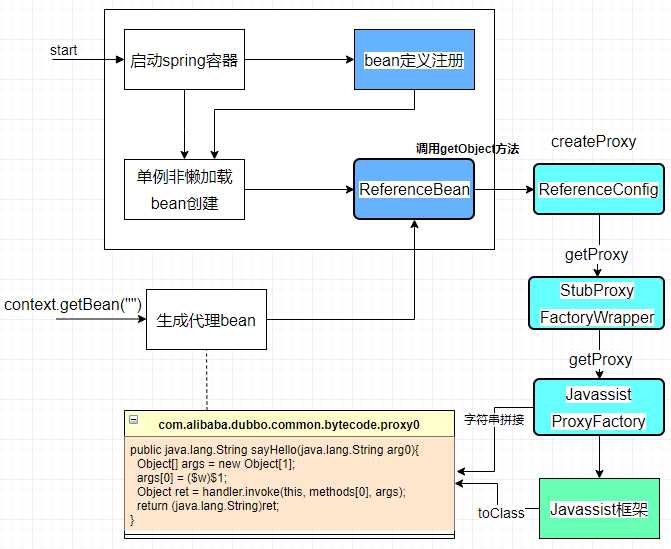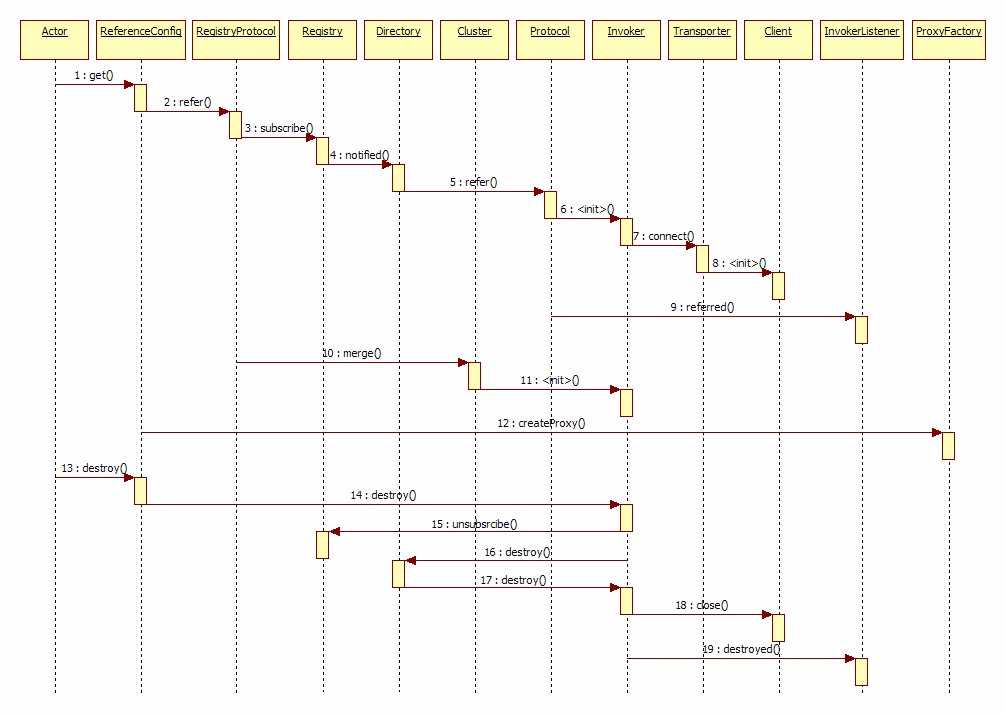标签:服务 theme loading objectc 图片 access desc classname protect



protected <T> T doGetBean( final String name, final Class<T> requiredType, final Object[] args, boolean typeCheckOnly) throws BeansException { final String beanName = transformedBeanName(name); Object bean; // Eagerly check singleton cache for manually registered singletons. // spring容器在启动完成后FactoryBean就已经创建好了,demoService属于ReferenceBean工厂bean Object sharedInstance = getSingleton(beanName); if (sharedInstance != null && args == null) { if (logger.isDebugEnabled()) { if (isSingletonCurrentlyInCreation(beanName)) { logger.debug("Returning eagerly cached instance of singleton bean ‘" + beanName + "‘ that is not fully initialized yet - a consequence of a circular reference"); } else { logger.debug("Returning cached instance of singleton bean ‘" + beanName + "‘"); } } // 关键代码 sharedInstance为ReferenceBean bean = getObjectForBeanInstance(sharedInstance, name, beanName, null); } // 省略若干代码... }
protected Object getObjectForBeanInstance( Object beanInstance, String name, String beanName, RootBeanDefinition mbd) { // Don‘t let calling code try to dereference the factory if the bean isn‘t a factory. if (BeanFactoryUtils.isFactoryDereference(name) && !(beanInstance instanceof FactoryBean)) { throw new BeanIsNotAFactoryException(transformedBeanName(name), beanInstance.getClass()); } // Now we have the bean instance, which may be a normal bean or a FactoryBean. // If it‘s a FactoryBean, we use it to create a bean instance, unless the // caller actually wants a reference to the factory. if (!(beanInstance instanceof FactoryBean) || BeanFactoryUtils.isFactoryDereference(name)) { return beanInstance; } Object object = null; if (mbd == null) { // 第一次执行时,取出的结果为null object = getCachedObjectForFactoryBean(beanName); } if (object == null) { // Return bean instance from factory. FactoryBean<?> factory = (FactoryBean<?>) beanInstance; // Caches object obtained from FactoryBean if it is a singleton. if (mbd == null && containsBeanDefinition(beanName)) { mbd = getMergedLocalBeanDefinition(beanName); } boolean synthetic = (mbd != null && mbd.isSynthetic()); // 关键代码 object = getObjectFromFactoryBean(factory, beanName, !synthetic); } return object; }
protected Object getObjectFromFactoryBean(FactoryBean<?> factory, String beanName, boolean shouldPostProcess) { if (factory.isSingleton() && containsSingleton(beanName)) { synchronized (getSingletonMutex()) { Object object = this.factoryBeanObjectCache.get(beanName); if (object == null) { // 关键代码... object = doGetObjectFromFactoryBean(factory, beanName); // Only post-process and store if not put there already during getObject() call above // (e.g. because of circular reference processing triggered by custom getBean calls) Object alreadyThere = this.factoryBeanObjectCache.get(beanName); if (alreadyThere != null) { object = alreadyThere; } else { if (object != null && shouldPostProcess) { try { object = postProcessObjectFromFactoryBean(object, beanName); } catch (Throwable ex) { throw new BeanCreationException(beanName, "Post-processing of FactoryBean‘s singleton object failed", ex); } } this.factoryBeanObjectCache.put(beanName, (object != null ? object : NULL_OBJECT)); } } return (object != NULL_OBJECT ? object : null); } } else { // 关键代码... Object object = doGetObjectFromFactoryBean(factory, beanName); if (object != null && shouldPostProcess) { try { object = postProcessObjectFromFactoryBean(object, beanName); } catch (Throwable ex) { throw new BeanCreationException(beanName, "Post-processing of FactoryBean‘s object failed", ex); } } return object; } }
private Object doGetObjectFromFactoryBean(final FactoryBean<?> factory, final String beanName) throws BeanCreationException { Object object; try { if (System.getSecurityManager() != null) { AccessControlContext acc = getAccessControlContext(); try { object = AccessController.doPrivileged(new PrivilegedExceptionAction<Object>() { @Override public Object run() throws Exception { return factory.getObject(); } }, acc); } catch (PrivilegedActionException pae) { throw pae.getException(); } } else { // 核心方法,这个factory为ReferenceBean,因此直接调用ReferenceBean中getObject方法 object = factory.getObject(); } } // 省略若干代码... return object; }
public Object getObject() throws Exception { return get(); }
public synchronized T get() { if (destroyed) { throw new IllegalStateException("Already destroyed!"); } if (ref == null) { // 关键,所以这时间稍长一点的话,得到的结果为null init(); } return ref; }
上面采用非阻塞异步的方式
private void init() { // 省略若干代码... StaticContext.getSystemContext().putAll(attributes); // 核心方法 ref = createProxy(map); }
private transient volatile Invoker<?> invoker; private T createProxy(Map<String, String> map) { // 省略若干代码... if (isJvmRefer) { URL url = new URL(Constants.LOCAL_PROTOCOL, NetUtils.LOCALHOST, 0, interfaceClass.getName()).addParameters(map); // 核心方法,拿到invoker对象 invoker = refprotocol.refer(interfaceClass, url); } else { // 省略若干代码... if (urls.size() == 1) { // 核心方法,拿到invoker对象 // refprotocol为Protocol$Adpative对象 invoker = refprotocol.refer(interfaceClass, urls.get(0)); } else { // 省略若干代码... } } // 核心方法create service proxy // 将下面这段代码替换成 ProxyFactory$Adaptive 中 getProxy中的部分 return (T) proxyFactory.getProxy(invoker); }
public class ProxyFactory$Adaptive implements ProxyFactory { public Object getProxy(Invoker invoker) throws RpcException { if (invoker == null) throw new IllegalArgumentException("com.alibaba.dubbo.rpc.Invoker argument == null"); if (invoker.getUrl() == null) throw new IllegalArgumentException("com.alibaba.dubbo.rpc.Invoker argument getUrl() == null"); com.alibaba.dubbo.common.URL url = invoker.getUrl(); String extName = url.getParameter("proxy", "javassist"); if(extName == null) throw new IllegalStateException("Fail to get extension(ProxyFactory) name from url(" + url.toString() + ") use keys([proxy])"); ProxyFactory extension = (ProxyFactory)ExtensionLoader.getExtensionLoader(ProxyFactory.class).getExtension(extName); return extension.getProxy(invoker); } public Invoker getInvoker(Object arg0, Class arg1, com.alibaba.dubbo.common.URL arg2) throws RpcException { if (arg2 == null) throw new IllegalArgumentException("url == null"); com.alibaba.dubbo.common.URL url = arg2; String extName = url.getParameter("proxy", "javassist"); if(extName == null) throw new IllegalStateException("Fail to get extension(ProxyFactory) name from url(" + url.toString() + ") use keys([proxy])"); ProxyFactory extension = (ProxyFactory)ExtensionLoader.getExtensionLoader(ProxyFactory.class).getExtension(extName); return extension.getInvoker(arg0, arg1, arg2); } }
即:
// create service proxy // 下面的代码直接替换(T) proxyFactory.getProxy(invoker) 方法 com.alibaba.dubbo.common.URL url = invoker.getUrl(); String extName = url.getParameter("proxy", "javassist"); // extName为 javassist ProxyFactory extension = (ProxyFactory)ExtensionLoader.getExtensionLoader(ProxyFactory.class).getExtension(extName); // extension为StubProxyFactoryWrapper对象 // return (T) proxyFactory.getProxy(invoker); return (T) extension.getProxy(invoker);
public <T> T getProxy(Invoker<T> invoker) throws RpcException { T proxy = proxyFactory.getProxy(invoker); // 关键部分... if (GenericService.class != invoker.getInterface()) { // } return proxy; }
上面 proxyFactory为JavassistProxyFactory类型,所以进入到JavassistProxyFactory类,分析一下它的getProxy方法
public <T> T getProxy(Invoker<T> invoker, Class<?>[] interfaces) { return (T) Proxy.getProxy(interfaces).newInstance(new InvokerInvocationHandler(invoker)); }
先来分析一下前面一部分的Proxy.getProxy(interfaces) 方法
public static Proxy getProxy(Class<?>... ics) { return getProxy(ClassHelper.getClassLoader(Proxy.class), ics); }
这个方法特点长,但是非常重要
public static Proxy getProxy(ClassLoader cl, Class<?>... ics) { if (ics.length > 65535) throw new IllegalArgumentException("interface limit exceeded"); // 省略了若干代码 // use interface class name list as key. String key = sb.toString(); // key = com.alibaba.dubbo.demo.DemoService;com.alibaba.dubbo.rpc.service.EchoService; long id = PROXY_CLASS_COUNTER.getAndIncrement(); String pkg = null; ClassGenerator ccp = null, ccm = null; try { ccp = ClassGenerator.newInstance(cl); Set<String> worked = new HashSet<String>(); List<Method> methods = new ArrayList<Method>(); for (int i = 0; i < ics.length; i++) { if (!Modifier.isPublic(ics[i].getModifiers())) { String npkg = ics[i].getPackage().getName(); if (pkg == null) { pkg = npkg; } else { if (!pkg.equals(npkg)) throw new IllegalArgumentException("non-public interfaces from different packages"); } } ccp.addInterface(ics[i]); // --------------------- 代理的关键部分 START --------------- // for (Method method : ics[i].getMethods()) { String desc = ReflectUtils.getDesc(method); if (worked.contains(desc)) continue; worked.add(desc); int ix = methods.size(); Class<?> rt = method.getReturnType(); Class<?>[] pts = method.getParameterTypes(); StringBuilder code = new StringBuilder("Object[] args = new Object[").append(pts.length).append("];"); for (int j = 0; j < pts.length; j++) code.append(" args[").append(j).append("] = ($w)$").append(j + 1).append(";"); code.append(" Object ret = handler.invoke(this, methods[" + ix + "], args);"); if (!Void.TYPE.equals(rt)) code.append(" return ").append(asArgument(rt, "ret")).append(";"); methods.add(method); // 生成方法,就是给上面的字符串添加 方法名、方法返回类型及{、} ccp.addMethod(method.getName(), method.getModifiers(), rt, pts, method.getExceptionTypes(), code.toString()); } // --------------------- 代理的关键部分 START --------------- } if (pkg == null) pkg = PACKAGE_NAME; // create ProxyInstance class. String pcn = pkg + ".proxy" + id; // 如生成com.alibaba.dubbo.common.bytecode.proxy0 ccp.setClassName(pcn); ccp.addField("public static java.lang.reflect.Method[] methods;"); ccp.addField("private " + InvocationHandler.class.getName() + " handler;"); ccp.addConstructor(Modifier.PUBLIC, new Class<?>[]{InvocationHandler.class}, new Class<?>[0], "handler=$1;"); ccp.addDefaultConstructor(); Class<?> clazz = ccp.toClass(); clazz.getField("methods").set(null, methods.toArray(new Method[0])); // create Proxy class. String fcn = Proxy.class.getName() + id; ccm = ClassGenerator.newInstance(cl); ccm.setClassName(fcn); ccm.addDefaultConstructor(); ccm.setSuperClass(Proxy.class); ccm.addMethod("public Object newInstance(" + InvocationHandler.class.getName() + " h){ return new " + pcn + "($1); }"); // 这里直接调用toClass方法生成Class,使用了 Javaassist 框架 Class<?> pc = ccm.toClass(); proxy = (Proxy) pc.newInstance(); } catch (RuntimeException e) { throw e; } catch (Exception e) { throw new RuntimeException(e.getMessage(), e); } finally { // release ClassGenerator if (ccp != null) ccp.release(); if (ccm != null) ccm.release(); synchronized (cache) { if (proxy == null) cache.remove(key); else cache.put(key, new WeakReference<Proxy>(proxy)); cache.notifyAll(); } } return proxy; }
public java.lang.String sayHello(java.lang.String arg0){ Object[] args = new Object[1]; args[0] = ($w)$1; Object ret = handler.invoke(this, methods[0], args); return (java.lang.String)ret; }
标签:服务 theme loading objectc 图片 access desc classname protect
原文地址:https://www.cnblogs.com/caoxb/p/13140244.html